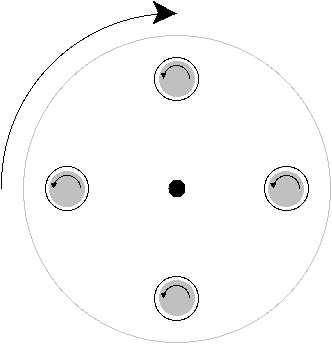-
Posts
129 -
Joined
-
Last visited
About THX-1138
- Birthday April 11
Profile Information
-
Location
NA, Terra, in orbit around Sol at 1.0 AU, Milky Way galaxy, Virgo supercluster, Universe of Discourse
-
Interests
Electronics, open software, machining, chemistry.. science in general.
-
Favorite Area of Science
Chemistry/machining
-
Biography
Open software expert
-
Occupation
Opinionist and software engineer
Retained
- Meson
Recent Profile Visitors
8055 profile views
THX-1138's Achievements

Baryon (4/13)
13
Reputation
-
Since both hands are holding down the paper at opposite corners, it's not going to move (at least not without some wrinkling, tearing, or other out-of-scope effects). So I have this contraption spinning with some moderate rate of RPMs, and I'm holding it by the bearings of the main spindle. I try to change its angle (say I push down with my left hand and up with my right). What will happen?
-

Effect of torque on equal and opposite gyroscopic influences?
THX-1138 replied to THX-1138's topic in Classical Physics
I imagine the rotors are designed to have low moments of inertia and use their lift properties to counteract any precession effects caused by tilting the axis. I'm actually asking about the other end of things; coaxial spinning disks with high (and equal) moments of inertia, and high angular velocities -- what happens if an attempt is made to tilt the axis? -

N00b question about learning about magnetism
THX-1138 replied to THX-1138's topic in Classical Physics
I see I was unclear. What [common] core materials make the best electromagnets? (Concentrate the field best, but for which the persistence of any induced field is minimal.) What are the best materials (e.g., PVC, paper/cardboard, non-magnetic metal) upon which to wrap windings for an air-core electromagnet? As in, the hollow cylinder upon which the windings are wrapped? Okey, good to come back to it. If the device in question is a hollow cylinder with multiple successive windings along its length, and the goal is to energise the windings in such a way as to propel or position a slug along the interior of the cylinder, should the slug (presumably of a magnetic material) have its own field, or be made of something in which an induced field is unlikely to persist? I hope that is better. And as for learning about magnetism from scratch, StringJunky, what source(s) would you recommend? -
THX-1138 started following What is Magnetism ? , N00b question about learning about magnetism , More on gyroscopic behaviours and 2 others
-
I'll probably get slapped around for this, but I'm looking for moderately dumbed-down texts about magnetism. The sort of 'whats' and 'hows' I want to know include things like What [common] materials make the best electromagnets? (I.e., most powerful when energised. least retained magnetism when de-energised.) What are the best materials for an air-cored electromagnet closed at both ends (such as for an oscillating actuator)? If I use electromagnets along an air-core channel, what should the spacing be? The strength? What do the field rise and fall curves look like (so the next can be energised with minimal loss to the falling field of the previous one. Where in the travel of the magnetic core should one trip on, or off? What sort of material would one use for the slug in an air-cored actuator? Iron? Steel? Ferrite? A neodymium magnet? All those, and then I'd like to understand the 'why' (or 'why not') aspects of each. But I don't know the terminology to ask for what I don't know. Links to references sources would be great? Thanks!
-
Actually, the grey circles show the direction of rotation to be contra to that of the larger wheel; it didn't come out clearly in the diagram, I guess. The axes of the smaller gyroscopes are parallel to that of the larger one; they are all parallel to the [latex]Y[/latex] axis. AND I clearly stated that the small discs were rotating contra to the large one (widdershins vs clockwise). I am not a mathematician, so my gut feeling is that, since there are no precessional forces at play when the experiment is in its unstressed state, all of the gyroscopes having parallel axes, so my first question would be about that behaviour, and the effect of altering rotational velocities. The diagram is a top-down view. I'll take your word that 'effects' would cancel out on opposite sides of the large disk. Which effects, though? And what would happen if force were applied to, say, rotate the structure around the [latex]X[/latex] axis?
-

Effect of torque on equal and opposite gyroscopic influences?
THX-1138 replied to THX-1138's topic in Classical Physics
All right, I will. I didn't think of that example. Why are you being so unpleasant? Were you born knowing everything? I'm sorry I wasn't. It's rather a put-off to ask questions here to get slapdowns like the above. -

Effect of torque on equal and opposite gyroscopic influences?
THX-1138 replied to THX-1138's topic in Classical Physics
They're welded into a framework containing them both, not to each other. -
Replace 'flywheel' with 'fairly massive disc,' and 'counterclockwise' with 'counterclockwise when viewed from above.'
-

Effect of torque on equal and opposite gyroscopic influences?
THX-1138 replied to THX-1138's topic in Classical Physics
I'm being serious. I'm wondering about the situation of freedom being restricted in two of the directions of precession. All right, either the spindles are Klein manifolds or some engineering ingenuity is used to get the wheels, spinning each on its own spindle, as close as possible and welded into a single unit, so precession forces will apply to the entire structure. -
The larger wheel and its spindle are one piece, and are spinning; assume frictionless bearings for normal conditions. The bearings of the smaller gyroscopes' spindles are fixed to the larger wheel, but the wheels themselves are free to rotate upon those spindles.
-

Effect of torque on equal and opposite gyroscopic influences?
THX-1138 replied to THX-1138's topic in Classical Physics
Irrelevant. Assume the spindle is turning, and is being suspended in touchless magnetic bearings and driven by magnetic induction motors. Assume frictionless under normal circumstances. -
Posit a flywheel as a gyroscope, rotating clockwise Now consider the flywheel pierced at regular intervals aeound the circumference, and in each piercing there is another gyroscope rotating widdershins. and that the sum of their angular momentums is equal but opposite to that of the larger flywheel. [latex]\sum_{1}^{4} L(small~gyro~n) = - L (large~gyro)[/latex] What behaviours or peculiarities could be expected from such a framework, even before force was applied to the [latex]Z[/latex] axis?
-
Suppose you have a heavy flywheel rotating about a spindle in thr [latex]X[/latex] axis at a considerable rate of radians/sec. Now suppose you have another one on the same spindle -- same mass, same diameter, etc, but colocated and rotating in the opposite direction. What will happen if force is applied to rotate the spindle about the [latex]Z[/latex] axis? (I'm guessing lots of resistance, leading eventually to catastrophic heat transfer.)
-
I recently purchased some 7Ω 1% resistors and used one in a circuit. However. my digital multimeter says it's closer to 11Ω, which is 'way outside the 1% tolerance. My meter isn't top of the line, so this made me wonder: How much can I trust it, and for that matter, how can I trust any meter readings? How typical is miscalibration in low-end measurement devices? Or should I trust the meter and gritch at Mouser that the Vishay resistors they sold me are monstrously out of tolerance? (Or at least one of them; I haven't checked all of them.) Thanks!
-
Maybe I should start a new topic for this, but the wealth of knowledge exhibited here is too awesome. Many introductory materials talk about (and use in illustrations) 'lines of force' when covering magnetism. Is that an accurate concept, or a fiction for illustrative purposes? Are there actually discrete force lines, or is it a continuous field? I'm looking for materials that, when used as the core of a coil, will strongly enhance the coil's magnetic effects. However, I'm looking for materials that will retain as little as possible of any induced magnetism -- and other materials that will retain as much as possible. I don't know what terms to use nor where to look; can anyone provide we with some links or pointers? Thanks very much!



